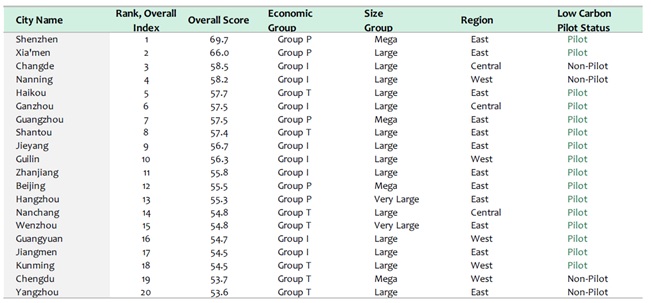Progress to date: Chinese cities going green and low-carbon
Cities around the world are stepping up action to achieve Sustainable Development Goal 11 – make cities and human settlements inclusive, safe, resilient and sustainable – and making bold commitments to combat climate change. Buildings are one of the largest sources of greenhouse gas emissions in urban areas, and 19 global cities are working to ensure that new buildings operate at net zero carbon by 2030, and existing buildings are to be net zero by 2050.
Chinese cities are keeping up with the pace of global sustainable development. Since its launch in 2010, China’s national low-carbon pilot programme has gathered 81 cities and 6 provinces to experiment with solutions that facilitate the transition to a low-carbon future. Other policy efforts are in place to address imminent sustainability issues, such as the recently launched 2020 action plan for air pollution. Between ideal and reality, it is worth examining the progress to date and identifying the ways forward. To assess the performance of China’s cities in their transition towards energy sustainability from 2010 to 2015, Innovative Green Development Programme(iGDP), joining hands with Lawrence Berkeley National Lab (LBNL), conducted a comprehensive study on a diversified group of 115 cities. With reference to international and domestic indicator systems, researchers developed and adopted the system of “LOGIC” (China Low-Carbon and Green Index for Cities) that:
- Measures physical indicators in the following categories:
- Economic dimension (i.e. energy consumption/GDP, CO2 emissions/GDP)
- Energy and power (i.e. energy consumption/capita, non-fossil fuel energy, CO2/capita)
- Industry (i.e. heavy industry GDP share, industrial energy intensity)
- Buildings (i.e. residential energy/capita, commercial energy/employee, green buildings share)
- Transport (i.e. bus trips/capita, public trans vehicle/10k person, urban rail extent)
- Environment and land use (i.e. blue sky days, solid waste/capita, energy environment budget ratio, green scape/capita, water consumption/capita, PM2.5)
- Measures policy indicators such as planning, budgeting, governance, and citizen engagement
- Benchmarks performances of Chinese cities against global best practices
The report results, launched in this September, reveal some interesting findings:
Chinese cities are getting greener, but there is still room for improvement.
Across all measured indicators, the aggregate score of all selected cities was increased by 6.6% from 2010 to 2015, indicating that China continued to progress towards green and sustainable urban development during this time period. Nevertheless, when benchmarked against some world-class best practices in countries and regions like Japan, Singapore, Hong Kong and the European Union, even the top 3 best-performing cities – Shenzhen, Xia’men, and Changde – could still increase their green performance by 30 points or more (out of a full LOGIC score of 100 points).
Going green and low-carbon may not come at odds with economic growth of Chinese cities.
Between 2010 and 2015, more than 78% of selected cities demonstrated percentage increases in both their green and low-carbon performance (captured by higher LOGIC scores) and GDP. In particular, the fastest growing cities from western China like Urumuqi and Lanzhou with the highest GDP growth still enjoyed a 5-15% increase in their LOGIC scores. Meanwhile, larger and more advanced eastern cities, such as Shenzhen, Changde and Haikou, which have achieved the best results in green development, did not sacrifice their economic growth, but instead stayed above the national average of GDP growth.
China’s sustainable urban development needs to be strategized and prioritized according to different levels of economic development.
Preliminary analysis of the report results suggests that low-carbon policies and pathways should be designed with different priorities that meet the varying needs of cities:
- The 10 “Post-industrial” cities (e.g. Shenzhen and Wuhan) with the highest levels of wealth and urbanized population, a large service sector and a post-industrial economy, should focus on transportation systems, improving energy efficiency of buildings, and the promotion of low-carbon lifestyles among their residents.
- The 58 “Transition” cities (e.g. Chongqing and Lanzhou) that are transitioning from large heavy-industry and manufacturing sectors towards a more service-oriented economy, should prioritize decarbonization in their economic structure, such as by reducing the share of heavy industry and investing more in the areas of consumption, technology and information-oriented growth.
- The 47 “Industrial” cities (e.g. Guilin and Baoding), with industry-dominated economies and the lowest levels of GDP per capita and urbanization rates, should enhance performance in industrial energy efficiency and investment in low-carbon and non-fossil fuel power sources.
*Top 20 cities leading in green and low-carbon development (ranked by 2015 overall LOGIC scores)

Moving forward, the LOGIC indicator system will continue to serve as a useful framework for city leaders and policymakers in China to comprehensively and strategically understand the sustainability performances of cities, looking beyond conventional economic indicators and making better-informed policy decisions. Since Chinese cities are experiencing fundamental economic restructuring towards more balanced, inclusive, and sustainable growth, it is also imperative for businesses operating in China to proactively embrace the opportunities of sustainable development.
For more insights, the full report can be downloaded at iGDP’s website.
